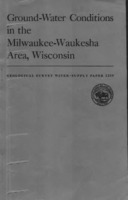Ground-water conditions in the Milwaukee-Waukesha area, Wisconsin
Links
- Document: Report (pdf)
- Plates:
- NGMDB Index Page: National Geologic Map Database Index Page (html)
- Download citation as: RIS | Dublin Core
Abstract
Three major aquifers underlie the Milwaukee-Waukesha area: sandstones of Cambrian and Ordovician age, Niagara dolomite of Silurian age, and sand and gravel deposits of Pleistocene age. The Maquoketa shale of Ordovician age acts as a more or less effective seal between the Pleistocene deposits and Niagara dolomite above and the sandstone aquifer below. Crystalline rocks of pre-Cambrian age form an impermeable basement complex below the Paleozoic sedimentary rocks. The Paleozoic strata dip east at 25 to 30 feet to the mile. There is no evidence that any of the faults and folds known or surmised to be present acts as a barrier to the movement of ground water.
The bedrock surface underlying the Milwaukee-Waukesha area is formed by the Niagara dolomite except in northeastern Milwaukee County, where it is dolomite and shale of the Milwaukee formation of Devonian age, and in some of the preglacial valleys where the uppermost bedrock formation is the Maquoketa shale. Unconsolidated deposits of glacial drift cover the surface of the bedrock almost completely.
Buried valleys in the bedrock surface contain as much as 150 feet of water-bearing sand and gravel deposits. These deposits, along with the Niagara dolomite, could be developed as sources of water supplemental to that of the sandstone aquifer. The Niagara dolomite is an important aquifer; it yields water from crevices and solution channels.
The sandstone aquifer consists of the Galena dolomite, the Platteville limestone, and the St. Peter sandstone of Ordovician age, and the Eau Claire and Mount Simon sandstones of Cambrian age. The St. Peter and Mount Simon are the most productive formations but the others supply some water to wells.
Static water levels in the shallow aquifers have not declined to any great extent except in downtown Milwaukee, where a 50-foot-deep cone of depression exists. Static water levels in the sandstone aquifer declined as much as 350 feet in the Milwaukee area from 1880 through 1950.
Recharge to the two shallow aquifers occurs locally from precipitation within the area. The major recharge area of the sandstone aquifer lies about 25 miles west of Wauwatosa. Some ground water is recharged to the sandstone aquifer locally by leakage from the Niagara dolomite, mostly through deep uncased wells.
Ground water is the source of six municipal supplies and many industrial and commercial supplies in the area. Pumpage from deep wells has increased from about 2.5 mgd in 1900 to about 25 mgd in 1949, of which 6.0 mgd was derived from the shallow aquifers. The total withdrawal from the shallow aquifers, including the 6.0 mgd from the deep wells, was about 19.5 mgd in 1949. Thus the total in 1949 was 38.5 mgd for the area as a whole.
Coefficients of transmissibility and storage for the sandstone aquifer were obtained by means of controlled pumping tests at Wauwatosa, Waukesha, Greendale, Town of Lake, and Jefferson. The coefficients were used to calculate the amount of water recharged from the Niagara dolomite to the sandstone aquifer in the area. About 5.5 mgd of the 23 mgd pumped from deep wells in 1950 was supplied locally by leakage from the Niagara dolomite. The coefficients, with corrections for boundaries, were also applied to past records of pumpage to calculate the water-level decline in the sandstone aquifer at Wauwatosa from 1880 through 1950. The calculated decline was 317 feet, and the actual decline was 307 feet.
The future water-level decline in the sandstone aquifer at Wauwatosa resulting from estimated future pumping conditions was computed. If the pumpage in the area as ?. whole increases from about 23 mgd in 1950 to about 28 mgd in 1960, the water levels at Wauwatosa will decline as much as 65 feet more by 1960.
It is estimated that the available recharge to the sandstone aquifer underlying the Milwaukee-Waukesha area is approximately 60 mgd.
It is recommended that new deep wells be located to the west toward the recharge area and that the shallow aquifers be used as auxiliary sources to void excessive lowering of water levels in the sandstone aquifers.
Conservation should be practiced by all users of ground water to avoid waste resulting in lower water levels and higher pumping costs.
Study Area
| Publication type | Report |
|---|---|
| Publication Subtype | USGS Numbered Series |
| Title | Ground-water conditions in the Milwaukee-Waukesha area, Wisconsin |
| Series title | Water Supply Paper |
| Series number | 1229 |
| DOI | 10.3133/wsp1229 |
| Year Published | 1953 |
| Language | English |
| Publisher | U.S. Geological Survey |
| Contributing office(s) | Wisconsin Water Science Center |
| Description | Report: v, 96 p.; 7 Plates: 12.50 x 10.00 inches or smaller |
| Country | United States |
| State | Wisconsin |
| County | Milwaukee County, Waukesha County |
| City | Milwaukee, Waukesha |
| Online Only (Y/N) | N |
| Additional Online Files (Y/N) | Y |


